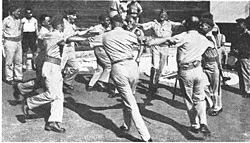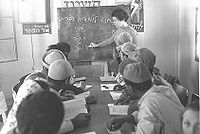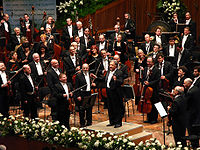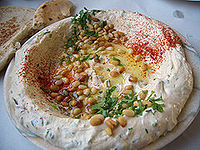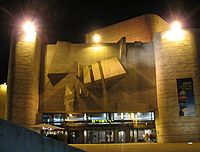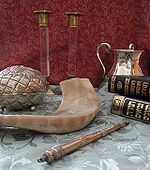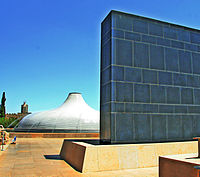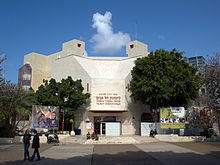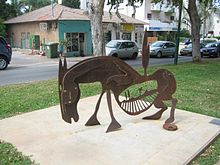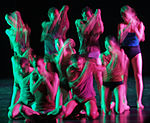- Culture of Israel
-
The culture of Israel developed long before the foundation of the State of Israel in 1948 and combines the heritage of secular and religious lives. Much of the diversity in Israel's culture comes from the diversity of its population. Originating around the world, immigrants arrived with diverse cultural backgrounds and contributed to the development of Israeli culture, which follows cultural trends and changes across the globe. Israeli culture also reflects Jewish history in the diaspora, especially the ideology of the Zionist movement beginning in the late nineteenth century.
Israeli traditions are rooted in a synthesis of ethnic and religious traditions, and Israeli artists continually push the boundaries of their art forms. Through their work, Israel's artists provoke self-reflective and communal examination and inspire social change, while expressing the beauty of the people and the land of Israel.[1]
Zionism is partly based on religious tradition. It links the Jewish people to the Land of Israel where the concept of Jewish nationhood first evolved between 1200 BCE and 70 CE (end of the Second Temple era). However, modern Zionism evolved as mainly secular.[2] It mostly began as a response to the widespread antisemitism toward European Judaism. It constituted a branch of the broader phenomenon of modern nationalism. Though Zionist groups were first competing with other Jewish political movements, Zionism became an equivalent to political Judaism during and after the Holocaust.
Contents
Cultivation of Hebrew language
As new immigrants arrived, Hebrew language instruction was of utmost importance. Eliezer Ben-Yehuda, who founded the Hebrew Language Committee, coined thousands of new words and concepts based on Biblical, Talmudic and other sources, to cope with the needs and demands of life in the 20th century. Learning Hebrew became a national goal, employing the slogan "Yehudi, daber ivrit" ("Jew - speak Hebrew"). Special schools for Hebrew language learning, ulpanim, were set up all over the country.[3]
Cultural influences in the Jewish Yishuv
The development of Israeli culture was very much influenced by aliyah or immigration waves. The Jewish pioneers who came to Palestine hailed from many countries and brought with them the cultures of their lands. Russian culture had an undeniable impact on the arts in Israel. Habima Theatre brought its Russian and Yiddish roots to the country.[4] Local Arab culture had an influence on dance, language and mannerisms. British culture was introduced during the period of the British Mandate of Palestine. German culture left its mark on the architecture of Israel, with many buildings in Tel Aviv and other cities inspired by the Bauhaus movement.
After the establishment of the state
Especially celebrated are works from the 1950s and the 1960s when art in modern Hebrew was created, in contrast to the poetry written previously, like that of Nathan Alterman, Avraham Shlonsky, and Leah Goldberg, or the literary style of one of the greatest Hebrew authors, S. Y. Agnon. The central figures of the modern poetry of the first decades were Yehuda Amichai, Nathan Zach and David Avidan. In the field of literature, most notable were Moshe Shamir and Aharon Megged along with Amos Oz, A. B. Yehoshua, Meir Shalev, and many more.
After the founding of the state in 1948, immigrants rushed to Israel from many different countries, but their influence on the Israeli culture happened only gradually and relatively. In the 1950s, the prominent effects on Israel were the cultures of England, France, and the United States. Since the early 1960s and more prominently in the 1970s, additional dominant effects began to appear. In theater, the Russian dominancy began to weaken gradually and other effects began to permeate such as the European theater of Bertolt Brecht. In music, in spite of the continuance of the French effect they began to weaken. Instead, a wide variety of effects, such as British popular music (and in particular The Beatles), Greek music, and a more updated Russian culture influenced Israeli culture.
The effect of the culture of the Jewish refugees from the Arab states on Israeli culture was considerable, but until the end of the 1970s, it was generally served by means of "middlemen". For example, prominent representatives of the Mizrahi culture on the stages was "HaGashash HaHiver" while the movies which dealt with the world of the Mizrahi Jews ("Bourekas films") were directed and acted almost always by non-Mizrahi Jews, including Ephraim Kishon, Boaz Davidson, and Menahem Golan and Gila Almagor, Yehuda Barkan, Chaim Topol, and Shaike Ophir. Since the beginning of the mid 1980s, the Israeli cultural arena became more open and varied. In the field of music, particularly popular music, the main influences were from Britain, Europe, and South America; in addition to those, Turkish, Greek, and Arab music gradually became more important. Since the inauguration of Israeli commercial television, high-quality local drama developed, adding another dimension to Israel Television, which had previously relied on imported series from England and the United States.
Overview
Israeli culture is heterogeneous and dynamic. With a diverse population of immigrants from five continents and more than 100 countries, and significant subcultures like the Palestinians, the Russians, and the Orthodox, each with its own newspapers and cultural networks, Israeli culture is extremely varied.
Tel Aviv is considered the hub of secular culture, although many leading cultural institutions are located in Jerusalem. The Israel Philharmonic Orchestra plays at venues throughout the country and abroad. The Israel Broadcasting Authority has a symphony orchestra that performs in Israel and around the world, and almost every city has its own orchestras, many of the musicians hailing from the former Soviet Union. Israeli dance companies, among them the Batsheva and Bat Dor, are highly acclaimed in the dance world. Theater is also an important facet of the culture of Israel. The national theater, Habima was established in 1917. Other theater companies include the Cameri Theater, Beit Lessin Theater, Gesher Theater (which performs in Hebrew and Russian), Haifa Theater and Beersheba Theater.
Safed, Jaffa and Ein Hod are home to artist colonies. Major art museums operate in Tel Aviv, Herzliya and Jerusalem, as well as in many towns and kibbutzim. Jerusalem's Israel Museum has a special pavilion showcasing the Dead Sea scrolls and a large collection of Jewish religious art, Israeli art, sculptures and Old Masters paintings.
Newspapers appear in dozens of languages, and every city and town publishes a local newsletter.
The heterogeneous nature of culture in Israel is also manifested in Israeli cuisine, a diverse combination of local ingredients and dishes and immigrant dishes from around the world. Since the establishment of the State of Israel in 1948, and particularly since the late 1970s, an Israeli fusion cuisine has developed with the adoption and continued adaption of elements of various Jewish styles of cuisine including Mizrahi, Sephardic, Yemeni Jewish and Ashkenazi[5] and many foods traditionally eaten in the Middle East.[6][7]
Melting pot approach
The first Israeli prime minister, David Ben Gurion, led a trend to blend the many immigrants who arrived at the first years of the state from Europe, North Africa, and Asia into one melting potthat will not differentiate between the older residents of the country and the new immigrants. The original purpose was to unite the immigrants with the veteran Israelis for the creation of a common Israeli culture in order to build a new nation in the new country.
The two central tools that were destined for this effect were the Israel Defense Forces and the education system.
- Israel Defense Forces - by the means of its transformation to the army of the nation which will constitute a common ground between all civilians of the country wherever they are.
- The education system - firstly in the method of unitary education, following the cancellation of the method of the currents in education and uniting the education system under the education laws, in order that different student from different sectors would study together at the same schools. In a gradual process the Israeli society became more pluralistic and the melting pot derided with the years.
Some critics of the melting pot consider it to have been a necessity in the first years of the state in order to build a mutual society but now claim that there is no longer a need for it. They instead see a need for Israeli society to enable the people to express the differences and the exclusiveness of every stream and sector. Others, mainly Mizrahi Jews and Holocaust survivors from Europe, criticized the early melting pot process. According to them, they were forced to give up or conceal their original heritage and culture, which they brought from their homelands, and to adopt a new "Sabra" culture. This has been articulated by the Anglo-Jewish writer Emanuel Litvinoff who lamented the denigration of the Yiddish language and objected to a Zionist 'chauvinism.'
Cultural avenues
Literature
The first works of Hebrew literature in Israel were written by immigrant authors rooted in the world and traditions of European Jewry. Yosef Haim Brenner (1881–1921) and Shmuel Yosef Agnon (1888–1970), are considered by many to be the fathers of modern Hebrew literature.[8] Brenner, torn between hope and despair, struggled with the reality of the Zionist enterprise in the Land of Israel. Agnon, Brenner's contemporary, fused his knowledge of Jewish heritage with the influence of 19th and early 20th century European literature. He produced fiction dealing with the disintegration of traditional ways of life, loss of faith and the subsequent loss of identity. In 1966, Agnon was co-recipient of the Nobel Prize for Literature.[8] Native-born writers who published their work in the 1940s and 1950s, often called the "War of Independence generation," brought a sabra mentality and culture to their writing. S. Yizhar, Moshe Shamir, Hanoch Bartov and Benjamin Tammuz vacillated between individualism and commitment to society and state. In the early 1960s, A.B. Yehoshua, Amos Oz, and Yaakov Shabtai broke away from ideologies to focus on the world of the individual, experimenting with narrative forms and writing styles such as psychological realism, allegory and symbolism. Since the 1980s and early 1990s, Hebrew literature has been widely translated and several Israeli writers have achieved ohya international recognition.[8]
Visual arts
From the beginning of the 20th century, visual arts in Israel have shown a creative orientation influenced by the encounter between East and West, as well as by the land itself and its development, the character of the cities, and stylistic trends emanating from art centers abroad. In painting, sculpture, photography, and other art forms, the country's varied landscape is the protagonist: the hill terraces and ridges produce special dynamics of line and shape; the foothills of the Negev, the prevailing grayish-green vegetation and the clear luminous light result in distinctive color effects; and the sea and sand affect surfaces. On the whole, local landscapes, concerns, and politics lie at the center of Israeli art and ensure its uniqueness.[9]
The earliest Israeli art movement was the Bezalel school of the Ottoman and early Mandate period in which artists portrayed both Biblical and Zionist subjects in a style influenced by the European jugendstil (or art nouveau) movement, symbolism, and traditional Persian and Syrian artistry.
Israel has a lively gallery scene with galleries ranging form Tel Aviv's contemporary Raw Art Gallery to Jerusalem's more representational Mayanot Gallery.
Museums
With over 200 museums, Israel has the highest number of museums per capita in the world, with millions of visitors annually.[10] Museums in Israel include:
Music
Classical music in Israel has been vibrant since the 1930s when hundreds of music teachers and students, composers, instrumentalists and singers, as well as thousands of music lovers, streamed into the country, driven by the threat of Nazism in Europe. The founding of The Palestine Philharmonic Orchestra (today the Israel Philharmonic Orchestra) 1936, marked the beginning of Israel's classical music scene. In the early 1980s, the New Israeli Opera began staging productions, reviving public enthusiasm for operatic works. The Russian immigration in the 1990s boosted the classical music arena both with new talents and music lovers. The contemporary music scene in Israel is hugely varied, dynamic and eclectic. It spans across all spectrums of musical genres and often fuses many musicals influences ranging from Ethiopian, Middle-Eastern soul, rock, jazz, hip hop, electronic, Arabic, pop and mainstream. Israeli music is versatile and combines elements of both western and eastern music. It tends to be very eclectic and contains a wide variety of influences from the Diaspora and more modern cultural importation: Hassidic songs, Asian and Arab pop (especially by Yemenite singers), and Israeli hip hop or heavy metal. Israel is also home to several world-class classical music ensembles such as the Israel Philharmonic and the New Israeli Opera. Also popular are various forms of electronic music, including trance, hard-trance, and goa-trance. Notable artists from Israel popular in this field are limited but include the psychedelic trance duo Infected Mushroom.
Dance
Traditional folk dances of Israel include the Hora and Yemenite dance. Israeli folk dancing today is choreographed for recreational and performance dance groups.
Modern dance in Israel has won international acclaim. Israeli choreographers, among them Ohad Naharin and Barak Marshall are considered among the most versatile and original international creators working today. Notable Israeli dance companies include the Batsheva Dance Company and the Kibbutz Contemporary Dance Company.[11] People come from all over Israel and many other nations for the annual dance festival in Karmiel, held in July. First held in 1988, the Karmiel Dance Festival is the largest celebration of dance in Israel, featuring three or four days and nights of dancing with 5,000 or more dancers and a quarter of a million spectators in the capital of the Galilee.[12][13] Begun as an Israeli folk dance event, the festivities now include performances, workshops, and open dance sessions for a variety of dance forms and nationalities.[14] Choreographer Yonatan Karmon created the Karmiel Dance Festival to continue the tradition of Gurit Kadman's Dalia Festival of Israeli dance, which ended in the 1960s.[15][16]
Famous companies and choreographers from all over the world have come to Israel to perform and give master classes. In July 2010, Mikhail Baryshnikov came to perform in Israel.[17]
Theater
The emergence of Hebrew theatre predated the state by nearly 50 years. The first amateur Hebrew theatre group was active in Palestine from 1904-1914. The first professional Hebrew theatre, Habimah, was founded in Moscow in 1917 and moved to Palestine in 1931, where it became the country's national theater.[18] The Ohel Theatre was founded in 1925 as a workers' theatre that explored socialist and biblical themes. The first Hebrew plays revolved around pioneering.
After 1948, two major motifs were the Holocaust and the Arab-Israeli conflict. Moshe Shamir's He Walked in the Fields in 1949 was the first produced by a sabra writing about sabras in idiomatic and contemporary Hebrew. In the 1950s, dramatists portrayed the gap between pre-state dreams and disillusionment. Other plays pitted native Israelis against Holocaust survivors.[18] Beginning in the 1960s, Hanoch Levin wrote 56 plays and political satires. During the 1970s, Israeli theatre became more critical, highlighting extreme images of Israeli identity, such as the muscleman versus the spiritual Jew. In the 1980s, Yehoshua Sobol explored Israeli-Jewish identity issues. Today, Israeli theatre is extremely diverse in content and style, and half of all plays are local productions.[18]
The 1980s-1990s saw development of new theaters created by massive emigration from Russia. Among best known are Educational Theater “Adrabah” created by playwright and director Leon Weinstein and “Gesher Theatre” created by prize winning director Yevgeny Arye. The actors, directors and supporting personnel in those theaters comprised mostly of new immigrants from Russia, and those theaters now regarded as an inseparable part of the Israeli culture
Cinema
Filmmaking in Israel has undergone major developments since its inception in the 1950s. The first features produced and directed by Israelis such as "Hill 24 Does Not Answer," and "They Were Ten," tended, like Israeli literature of the period, to be cast in the heroic mold. Some recent films remain deeply rooted in the Israeli experience, dealing with such subjects as Holocaust survivors and their children (Gila Almagor's "The Summer of Aviya" and its sequel, "Under the Domim Tree") and the travails of new immigrants ("Sh'hur", directed by Hannah Azoulai and Shmuel Hasfari, "late Marriage" directed by Dover Koshashvili). Others reflect a more predominant trend towards the present Israeli reality, whether dealing with the Israel-Arab and the Jews-Arabs confrontations (Eran Riklis's "The Lemon Tree", Scandar Copti and Yaron Shani's "Ajami"), the military aspects in the Israelis life (Joseph Cedar's "Beaufort", Samuel Maoz's "Lebanon", Eytan Fox 's "Yossi and Jagger") or set in the context of universalist, somewhat alienated and hedonistic society (Eytan Fox's "A Siren's Song" and "The Bobble", Ayelet Menahemi and Nirit Yaron's "Tel Aviv Stories"). The Israeli film industry continues to gain worldwide recognition through International awards nominations. For three years consecutively Israeli films have been nominated for an Academy Award, namely, "Beaufort" (2008), "Waltz with Bashir" (2009) and "Ajami" (2010). In 2009, "Lebanon" won the Golden Lion Award. Those achievements are among many more around the world.[19]
Sport
Main article: Sport in IsraelSports and Fitness are important in Jewish culture. Athletic prowess, which was prized by the Ancient Greeks, was looked down upon as an unwelcome intrusion of Hellenistic values. Maimonides, who was both a Rabbi and a Physician, emphasized the importance of regular Exercise in preventing illness on the authority of Hippocrates and Galen. This approach reiceved a boost in the 19th century from the Physical culture campaign of Max Nordau, and in the early 20th century when the Chief Rabbi of Palestine, Abraham Isaac Kook, declared that the body serves the soul, and only a Healthy body can ensure a Healthy soul.
The Maccabiah Games, an Olympic-style event for Jewish athletes and Israeli athletes, was inaugurated in the 1930s, and has been held every 4 years since then. In 1964, Israel hosted and won the AFC Asian Cup; in 1970, the Israel national football team managed to qualify to the FIFA World Cup, which is still considered the biggest achievement in Israeli Football.
Israel was excluded from the 1978 Asian Games due to Arab pressure on the organizers. The exclusion left Israel in limbo and it ceased competing in Asian competitions. In 1994, UEFA agreed to admit Israel and all Israeli sporting organizations now compete in Europe.
Football (soccer) and basketball are the most popular sports in Israel. The Israeli Premier League is the country's Premier Soccer League, and Ligat ha'Al is the premier basketball league. Maccabi Haifa, Maccabi Tel Aviv, Hapoel Tel Aviv and Beitar Jerusalem are the largest sports clubs. Maccabi Tel Aviv, Maccabi Haifa, and Hapoel Tel Aviv have competed in the UEFA Champions League and Hapoel Tel Aviv reached the Quarterfinal in the UEFA Cup. Maccabi Tel Aviv B.C. has won the European Championship in Basketball 5 times. Israeli Tennis champion Shahar Pe'er peeked 11th at the WTA rank list, a national record.
Beersheba has become a national chess center; thanks to Soviet immigration, it is home to the largest number of Chess grandmasters of any city in the world. The city hosted the World Team Chess Championship in 2005, and Chess is taught in the city's kindergartens. The Israeli Chess team won the silver medal at the 2008 Chess Olympiad, and the bronze medal at the 2010 Chess Olympiad. Israeli grandmaster Boris Gelfand is the current Chess World Cup holder.
To date, Israel has won seven Olympic medals since its first win in 1992, including a gold medal in Windsurfing at the 2004 Summer Olympics. Israel has won over 100 gold medals in the Paralympic Games and is ranked about 15th in the All-time Paralympic Games medal table. The 1968 Summer Paralympics were hosted by Israel.
Outdoor and vacation culture
Camping and hiking are an integral part of Israeli culture. National parks and nature reserves across Israel register some 6.5 million visits a year.[20] Schools and youth groups are taken on annual hiking trips throughout the country, raising children with an affinity for hiking and other outdoor activities. Consequently, many young Israelis take several months to a year off to travel the world, primarily to hike and experience the outdoors in remote, mountainous areas, like Nepal, India, New Zealand, Chile, and Peru.
Along the 190 kilometres (120 mi) of the Israeli Mediterranean coast, two thirds are accessible to bathing activities. Isrel has 100 surf bathing beaches guarded by professional lifeguards.[21] Matkot is a popular paddle ball game similar to beach tennis, often referred to as the country's national sport.[22]
See also
- List of Israeli musical artists
- List of Israeli visual artists
- List of Hebrew language poets
- List of Hebrew language authors
- List of Israeli actors
- List of Hebrew language playwrights
- Science and technology in Israel
- Religion in Israel
- Israeli cuisine
- Jewish ethnic divisions
References
- ^ Cultural Affairs: Introduction by the Cultural Affairs Department at the Embassy of Israel in London
- ^ Dr. Sergey Zagraevsky. The Past, the Present and the Future of the Jewish nation
- ^ Culture in Israel
- ^ On Israeli culture
- ^ A region's tastes commingle
- ^ Roden, The Book of Jewish Food, pp 202-207
- ^ Gur,The Book of New Israeli Food
- ^ a b c Focus on Israel: Language and Literature in Israel
- ^ CultureIL- Art - Everything about Israeli Culture and more
- ^ "Science & Technology". Consulate General of Israel in Los Angeles. Archived from the original on 2007-04-16. http://web.archive.org/web/20070416111417/http://www.israeliconsulatela.org/culture/Science.asp. Retrieved 2007-05-26.
- ^ Israeli Dance
- ^ "Galilee - Culture". Galilee Development Authority. http://www.galilee.gov.il/Galil_Eng/Templates/ShowPage.asp?TMID=84&FID=432. Retrieved 2007-08-06.
- ^ "Karmiel Dance Festival". ACTCOM-Active Communication Ltd.. http://www.dancefest.karmiel.israel.net/. Retrieved 2007-08-06.
- ^ "Karmiel Dance Festival". Karmiel Dance Festival. http://www.karmielfestival.co.il/index.php. Retrieved 2007-08-06.
- ^ "In Israel, Still Dancing After All These Years". Forward Association, inc.. 2004-04-16. Archived from the original on 2007-09-29. http://web.archive.org/web/20070929125546/http://www.forward.com/articles/in-israel-still-dancing-after-all-these-years/. Retrieved 2007-08-23.
- ^ "Gurit Kadman". PhantomRanch.net. http://www.phantomranch.net/folkdanc/teachers/kadman_g.htm. Retrieved 2007-08-06.
- ^ Mikhail Baryshnikov and Ana Laguna to Perform in Israel
- ^ a b c Israeli Theatre: A culmination of foreign and native influences
- ^ CultureIL- Films - Everything about Israeli Culture and more
- ^ Letter from Israel: Culture and Leisure
- ^ Beach Safety Management
- ^ Fogelman, Shay (2009-07-12). "Beach Paddle Battle". Haaretz. http://www.haaretz.com/hasen/spages/1099549.html.
External links
Categories:- Israeli culture
Wikimedia Foundation. 2010.

